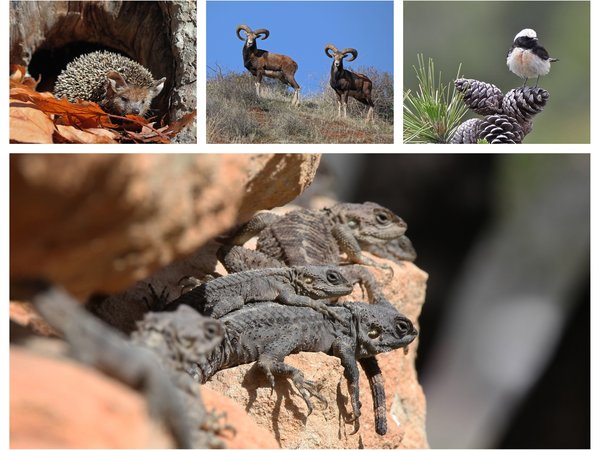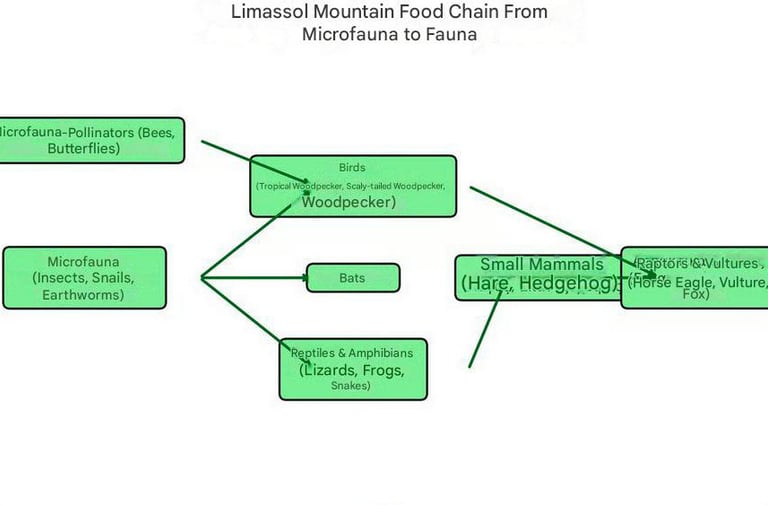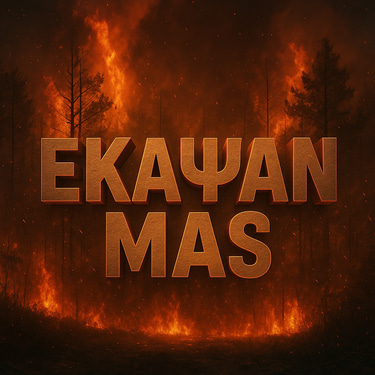Limassol MOUNTAIN FIRES 2025
LEARN about the villages evacuated, the total destruction of over 120km², the dead, the injured, the lives lost and the stories of survival and solidarity. photos, videos and volunteers from the fire front!
🌿 The Food Chain of the Limassol Mountains
🌿 The food chain of the Limassol Mountains begins with microfauna and pollinating insects, which support plants and grazing animals. These in turn become food for birds, reptiles and mammals, creating a delicate ecosystem of balance. The fires of 2025 severed this connection, threatening to collapse the entire network of life.
✍️ Team fothkia.com
8/17/20253 min read


In July 2025, the Limassol Mountains were the epicenter of the largest ecological disaster that Cyprus has experienced in peacetime. In just a few days, over 120 square kilometers of forests, agricultural lands and communities were reduced to ashes. Among the people who were uprooted and in the homes that were lost, thousands of animals were found – domestic, productive and wild.
The loss to wildlife is incalculable. It is not limited only to the immediate burned animals, but also to the long-term disappearance of habitats, the interruption of food chains, the reduction of pollination and the deregulation of entire ecosystems.
The following pages present a systematic record of the main species that were affected, which lived in the Limassol Mountains and how exactly they are affected in the short and long term by the fires.
The Limassol Mountains, and in particular the Limnati Valley, Ha Potami and Paramali River areas (Natura 2000), were home to some of the rarest and most important species of raptors and endemic birds of prey in Cyprus.
1.1 Griffon Vulture (Gyps fulvus)
Where it lives: A large carnivorous scavenger vulture, with a population of approximately 37 birds in Cyprus (according to the “VULTURES” program of the Game Service).
Importance: Biological “scrubber” of nature. It eliminates carcasses and reduces the risk of epidemics.
How it was affected: The fires burned down feeding grounds. The loss of sheep, goats and wild animals reduces the available food. In addition, the absence of large trees/rocks for nesting makes the species extremely vulnerable.
1.2 Bonelli’s Eagle (Aquila fasciata)
Where it lives: In the rocky ravines of Limassol, with a small number of pairs.
Importance: Considered an indicator of ecosystem health.
How it was affected: The fires reduced the hares and partridges it feeds on, leading to starvation. Potential nesting sites were also burned.
1.3 Short-toed Eagle (Circaetus gallicus)
Where it lives: Hunts snakes and lizards in the semi-mountainous areas.
Importance: Regulator of reptile populations.
How it was affected: As the fires killed off a large part of the reptiles, the species is facing a lack of food.
1.4 Long-legged Buzzard (Buteo rufinus)
Where it lives: A rare species of raptor that nests on cliffs.
How it was affected: It loses vital foraging areas. Landscape degradation limits its reproductive success.
1.5 Cyprus Warbler (Sylvia melanothorax)
Where it lives: A small endemic bird of Cyprus, lives in bushes and maquis vegetation.
How it was affected: The bushes have turned to ash. Populations will take decades to recover.
1.6 Cyprus Wheatear (Oenanthe cypriaca)
Where it lives: An endemic bird that loves open, dry landscapes with phrygana.
How affected: Burned landscapes may become temporarily suitable, but the lack of food (insects) makes its survival difficult.
2. Mammals
2.1 Hare (Lepus europaeus cyprius)
Where it lives: In the forests and heathlands of the mountain range.
How affected: The hare moves relatively slowly. Thousands are estimated to have been trapped in the flames. The population decline affects birds of prey and foxes.
2.2 Cyprus fox (Vulpes vulpes indutus)
Where it lives: Throughout Cyprus, but mountainous areas offer shelter and food.
How affected: Although more flexible in escaping, the lack of prey and the destruction of nests means a long-term population blow.
2.3 Bats (8+ species)
Where they live: Caves, ravines and tree hollows.
Importance: Control insect populations.
How they were affected: Lost roosting sites, destroyed water sources and reduced insect food.
3. Reptiles and Amphibians
3.1 Cyprus Lafiatis (Hierophis cypriensis)
Where they live: Endemic snake, mainly in bushes and rocky slopes.
How they were affected: Unable to escape from large fires; large numbers were killed.
3.2 Green lizard (Lacerta troodica)
Where they live: Lizard endemic to Troodos.
How they were affected: Loss of low vegetation means disappearance of microhabitats.
3.3 Frogs – Pelophylax cypriensis
Where they live: Streams and wet habitats.
How they were affected: Fires dried up springs, while the loss of shade increases evaporation.
4. Microfauna – The “invisible” loss
4.1 Bees (wild & domestic)
Where they live: Hives, logs, rock cavities.
How they were affected: Thousands of hives burned, pollination collapses. Without them, vegetation regeneration is almost impossible.
4.2 Butterflies (Hipparchia cypriensis and others)
Where they live: Fields with wildflowers and phrygana.
How they were affected: Host plants burned; entire populations are at risk.
4.3 Beetles (wood-boring, dung-boring)
Role: Recycling organic matter.
Impact: Population extinction, interruption of nutrient cycling in the soil.
4.4 Ants
Role: Aerate the soil, disperse seeds.
Impact: Thousands of colonies have disappeared.
4.5 Snails (endemic genera Troch


Who We Are
fothkia.com is an independent group of citizens and volunteers created after the 2025 fires in the Limassol Mountains. Our goal is prevention, protection and justice for the people, animals and environment of Cyprus. We do not represent parties or interests; we are ordinary citizens who refuse to remain silent.
Disclaimer
The content of the website is informative and awareness-raising, based on public sources, testimonies and personal opinions. It does not constitute an official position of state or legal entities. The management is not responsible for any errors or misinterpretations, while each report is made in good faith within the framework of freedom of expression. If anyone believes that they are being offended, they can contact us for clarification.
© 2025. All rights reserved.
